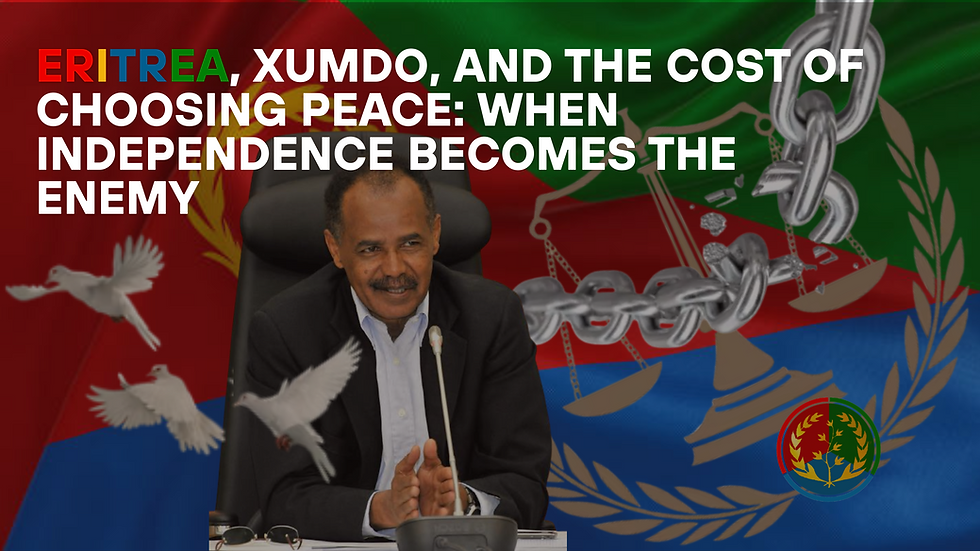East Africa in Crisis: The Wake-Up Call for African Unity and Sovereignty
- Nakfa Eritrea
- Mar 29
- 4 min read
Introduction The East African region stands at a critical crossroads, facing overlapping crises that threaten its stability and the sovereignty of its nations. From escalating conflicts and humanitarian emergencies to political dysfunction and Western manipulation, the landscape demands a unified, Pan-African response. This comprehensive analysis explores six major regional crises, connecting them to a broader narrative: the urgent need for Africans to reclaim their agency, reject neocolonial puppetry, and build a future rooted in self-determination.
1. Kenya's Mediation in South Sudan: A Trojan Horse? Kenya’s role as a mediator in South Sudan’s political deadlock, led by former Prime Minister Raila Odinga, is being celebrated in Western media as a diplomatic achievement. However, this intervention raises critical questions. Who really benefits from Kenya’s involvement? Kenya’s political elite have long been entangled with Western governments, corporations, and intelligence agencies. President William Ruto’s recent alignment with U.S. foreign policy objectives and economic interests makes it difficult to trust the impartiality of Kenya’s actions.
By inserting itself into South Sudan’s affairs under the guise of peacekeeping, Kenya risks advancing the agenda of foreign powers who prefer a divided, dependent Africa. For East Africans, this should serve as a red flag. We must interrogate every diplomatic move, especially when made by states heavily influenced by external interests.
2. Rebel Activity in Eastern DRC: A Manufactured Chaos The Democratic Republic of Congo (DRC) remains one of the most resource-rich yet unstable nations in Africa. The recent escalation of violence by the M23 rebel group, allegedly backed by Rwanda, has displaced thousands and deepened the crisis in the east. Yet again, Western complicity cannot be ignored. Multinational mining companies continue to exploit Congolese minerals, with proxy militias often serving their economic interests.
This manufactured chaos has become a profitable business for foreign powers, with African lives as the collateral. The DRC’s instability is not organic—it is engineered to ensure continued Western access to cobalt, gold, and coltan. As long as African nations fail to protect each other and confront these imperial designs, they will remain pawns in a global game.
3. Political Tensions in Ethiopia's Tigray Region: From Peace to Uncertainty Ethiopia’s Tigray conflict, which seemed to reach a ceasefire in 2022, remains unresolved beneath the surface. Tensions between the federal government and Tigrayan forces simmer, fueled by grievances and distrust. The U.S. and European actors played double roles during the conflict—condemning human rights violations while also leveraging the chaos for geopolitical influence.
The peace agreement may have temporarily halted violence, but the root causes—centralized power, economic disparity, and ethnic federalism—remain unaddressed. For Pan-Africanists, the lesson is clear: peace cannot come from external pressure or compromise deals orchestrated in Western capitals. True peace must be owned, initiated, and protected by Africans.
4. The Humanitarian Crisis in Tigray: Weaponizing Suffering The Tigray region continues to suffer from mass displacement, food shortages, and restricted aid access. Humanitarian aid, often managed by Western NGOs and agencies, has been used as a tool of influence rather than neutral relief. While civilians starve, Western narratives shift blame without accountability.
Aid dependency has become a subtle weapon, undermining national sovereignty. African governments must recognize that relying on international humanitarianism without building internal resilience only deepens neocolonial control.
5. East African Community Leadership Challenges: A Divided House The East African Community (EAC) was envisioned as a vehicle for regional integration and strength. Yet it now suffers from leadership struggles, mistrust, and policy contradictions. The ineffective deployment of the EAC Regional Force to the DRC is just one example of the bloc’s current dysfunction.
Instead of uniting to confront common enemies and mediate internal disputes with integrity, EAC members often operate in silos—some acting on behalf of Western powers, others pursuing selfish political gains. Until the EAC liberates itself from these external and internal shackles, it will continue to fail the people it was designed to serve.
6. Forced Deportations in Kenya: Exposing the Myth of Pan-African Solidarity Kenya has traditionally been seen as a safe haven for dissidents and political refugees across the continent. However, the recent abduction and deportation of activists—including Tanzanian journalist Maria Sarungi—shows a darker reality. These acts reveal a Kenya that collaborates with authoritarian regimes and foreign interests to silence Pan-African voices.
Forced deportations violate not only international law but also the spirit of African solidarity. When one African country betrays another’s freedom fighter, it sends a chilling message to all who dare to speak out: the enemy is not just outside; he is within.
Conclusion: The Call for a New African Consciousness What connects all these crises is a disturbing pattern: African nations acting as proxies for Western interests, willingly or under coercion. Whether through conflict mediation, economic policies, or military deployments, the sovereignty of African states is being undermined.
It’s time for Africans to wake up. We must shed the illusions of post-colonial independence and recognize that true liberation has yet to be achieved. The future of East Africa—and the continent at large—depends on grassroots movements, visionary leadership, and unified resistance to neocolonial influence. Our solutions will not come from the UN or Washington but from the wisdom of our elders, the resilience of our youth, and the solidarity of our people.
The choice is ours: continue as puppets, or rise as protectors of our land, legacy, and people.
.png)



Comments